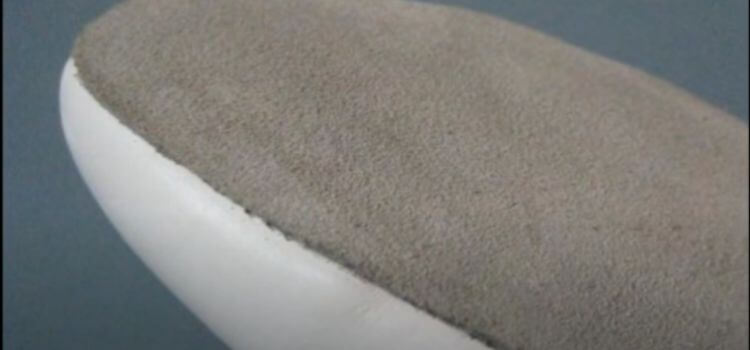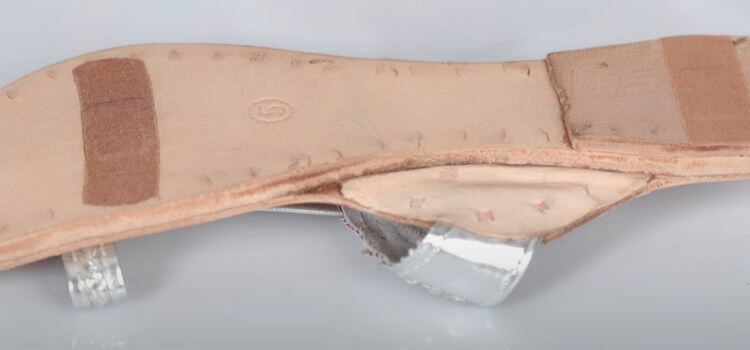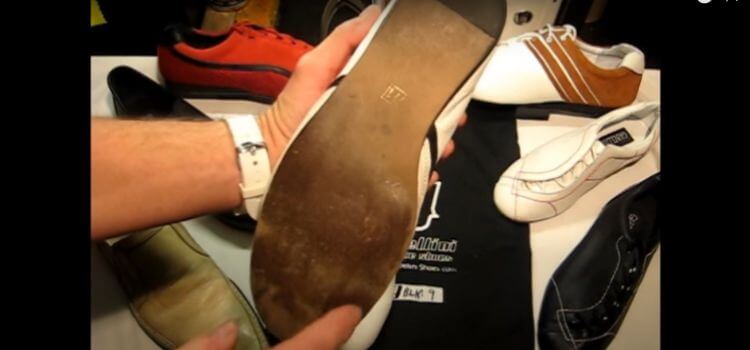Scuff the soles or apply a non-slip product to make dance shoes less slippery. Dancers can also use hairspray for temporary tackiness on their boots.
Dance enthusiasts often encounter slippery shoes, which can impede performance and pose a safety risk. With many dances requiring confident and graceful movements, ensuring the right amount of grip on dance shoes is paramount. This brief guide addresses the common issue of slick soles by presenting straightforward solutions.
Whether you’re a professional dancer or enjoy hitting the dance floor socially, this information can enhance your experience by reducing the chances of slips and falls. We’ll explore practical tips and simple techniques to achieve the perfect balance of slide and stability in your dance footwear, keeping your focus on your style and rhythm.

Introduction To Dance Shoes And Traction
Dancers know that the right balance of grip and slide is essential. It’s the secret to performing flawless pirouettes and seamless glides without slipping on stage. Finding this equilibrium starts with understanding the science of dance shoes and how traction comes into play.
Dance shoes are unique. They are designed to allow dancers to move effortlessly across the dance floor while providing enough resistance to prevent falls. The proper traction on your dance shoes can make or break your performance.
Understanding The Balance Of Grip And Slide In Dance Footwear
Every dance style demands a specific type of shoe. For instance, ballet, tap, or jazz shoes are crafted to cater to different movements. A ballet slipper’s sole allows for smooth gliding and elegant lines, whereas tap shoes need enough grip to create crisp sounds without slipping. Dancers aim for a sole that lets them slide with control and grip when necessary.
- A ballet shoe’s slim, flexible sole permits effortless turns.
- Tap shoes have a solid sole for precise rhythms.
- Jazz shoes blend flexibility and support for dynamic moves.
Factors Contributing To Slippery Dance Shoes
Sometimes, dance shoes become too slippery. This could be due to several factors that affect their traction. By identifying these, dancers can take steps to improve grip.
| Factor | Effect on Traction |
| Material wear | Smoothens sole, reducing grip |
| Floor conditions | Wax or dust can cause sliding |
| Moisture | Makes the surface slippery |
Worn-out soles or those exposed to too much polish and wax lose their natural texture. This leads to decreased friction and more slip. Moisture from sweat or a wet floor also creates a slick surface. Regular maintenance and the proper techniques can restore the necessary grip for safe and impressive dancing.
Preparatory Measures For New Dance Shoes
Stepping onto the dance floor with confidence starts with the right pair of shoes. But a shiny new team can sometimes be too slippery, making your first dance experience one to forget. Before you show off your moves, let’s ensure those new dance shoes give you the grip you need. Follow these preparatory measures to avoid unwanted slips.

Proper Fit And Selection: Foundation For Less Slip
Choosing the proper dance shoes is crucial. A perfect fit is the key to less slippage. Shoes should snugly hug your feet without causing discomfort. Your heel should not slip out as you move. Instead, it should feel secure. To avoid slips, follow these simple guidelines:
- Measure your feet late in the day when they are at their largest.
- Select shoes designed for your dance style. Different styles need different levels of traction.
- Try on several pairs with your dance socks or stockings to find the best fit.
- Walk around for a few minutes to ensure comfort and stability.
Initial Treatments: Scuffing And Pre-wearing
Brand-new soles often need a little roughing up to increase friction. Begin by gently scuffing the bottoms on a slightly abrasive surface. Avoid damaging the shoe, though. Consider these initial treatments:
- Use sandpaper to lightly rub the sole.
- Rub the soles against a clean, concrete surface with gentle pressure.
- Pre-wear your shoes at home to start the natural scuffing process.
Initial treatments prepare your shoes for optimal performance. Ensure thorough scuffing but maintain the integrity of the soles. Activating grip through scuffing supports your dance journey from the first step.
Standard Methods To Enhance Traction
Dance shoes must provide the perfect balance between slip and grip. It’s too slippery, and you risk falling. Not being tricky enough means less movement on the dance floor. Let’s check out some proven ways to get that balance right
Temporary Solutions: Hairspray And Rosin
For a quick fix, hairspray is your go-to. Spray it on the soles of your shoes and let it get tacky. You’ll find your boots stick better for a few dances. Rosin, used by athletes and musicians, also works. Crush it up, spread it on the floor, and step in. Stickiness will improve immediately.
Long-term Methods: Adhesive Sprays And Non-slip Soles
Adhesive sprays offer a more durable option. Just apply a thin layer to the soles of your shoes. For an even longer-lasting solution, consider attaching non-slip soles. They are specially designed for dancers and last many practices and performances.
Diy Traction Enhancements: Sandpaper And Duct Tape
Looking for home solutions? Take sandpaper and gently rub your shoe soles to create texture. This simple step can enhance their grip. Another method is duct tape. Stick a piece on the sole and enjoy instant traction. Remember, replace the video as it wears out.
On-the-floor Techniques To Increase Grip
On-the-floor techniques to Increase grip become essential when dancers slip on the dance floor. Adjusting the traction of dance shoes isn’t just about safety; it’s about performance and confidence. With clever tricks and maintenance tips, dancers can enhance their shoe grip and take their performance to the next level. Below, discover how to manage floor conditions and adopt dancer-specific practices for the ultimate dance experience.
Floor Maintenance: Cleaning And Surface Treatments
Keeping the dance floor clean is the first crucial step in reducing slipperiness. Dirt, dust, and other residues reduce traction, leading to unwanted slips. Regular cleaning and surface treatments offer an effective solution. Here’s how:
| Cleaning Routine | Surface Treatments |
| Sweep with a microfiber mop to remove particles. | Apply grip-enhancing solutions or antislip coatings. |
| Clean with appropriate solutions for your floor type. | Consider rosin bags in high-humidity areas. |
| Avoid waxes or polishes that make floors slippery. | Test small areas before widespread application. |
Dancer Practices: Moisture Management And Weight Distribution
Moisture and improper weight distribution can impair dance shoe grip. Dancers must address these factors with focused practices:
- Stay Dry: Use antiperspirant on feet, and keep a hand towel nearby to wipe off sweat.
- Choose the Right Shoes: Wear shoes with a moisture-absorbing lining.
- Even Pressure: Practice distributing weight evenly across the foot.
- Engage Core: A strong core helps with balance and stability.
By adopting these tactics, dancers ensure constant contact and friction with the floor. This results in a noticeable increase in shoe grip and a more secure performance.
Aftercare And Maintenance Of Dance Shoes
Keeping your dance shoes in top shape is vital to nailing the routine. Proper aftercare and maintenance ensure your shoes remain comfortable and less slippery. Let’s dive into making sure your dance shoes last for many performances to come.

Routine Cleaning And Inspection Of Soles
Dance shoe soles need regular attention to maintain grip. Follow these steps:
- Wipe the sole with a cool cloth to remove dirt.
- Brush suede soles with a special wire brush.
- Check for wear and tear after each use.
Stay diligent with sole care to prevent slips on the dance floor.
Storage And Care To Preserve Shoe Condition
Proper storage extends your shoe’s life. Remember these tips:
- Avoid heat and moisture to prevent material damage.
- Use a shoe bag or box with ventilation for storage.
- Insert shoe trees to maintain shape.
When To Replace Or Resurface Dance Shoes
Know when to give your dance shoes a makeover:
| Signs | Action |
| Thin or smooth soles | Resurface or add a new sole layer |
| Irreparable damage | Time to replace since safety comes first |
Safety Considerations And Best Practices
For dancers, finding the perfect balance between a shoe that grips and one that allows for smooth movement is crucial. Safety is just as important as nailing the ideal routine, so understanding how to make dance shoes less slippery can make all the difference. Best practices involve proactive approaches to maintain the proper traction, ensuring performance quality and personal safety are harmonious.
Navigating The Trade-off Between Safety And Performance
Dance shoes should provide enough friction to prevent falls without hindering movement. Proper shoe maintenance is vital. Here’s how:
- Roughen the soles slightly with sandpaper.
- Apply a specialized coating to increase traction.
- Use adhesive sprays for a temporary grip.
Each method affects performance differently, so trial and error may be necessary.
Listening To Your Body: Recognizing When Shoes Are Too Slippery
Your body often sends signals when safety is at risk. Pay attention to:
- The stability of your footing during turns.
- How confidently you land jumps.
- A muscle strain may indicate overcompensation for lack of grip.
Timely adjustments ensure continued safety and performance.
Consulting With Professionals: Instructors And Cobblers
Seek advice from experienced dancers and shoe experts:
| Instructors | Cobblers |
| Offer personalized tips based on your dance style. | Recommend sole treatments or modifications. |
Incorporating professional insights can significantly enhance your approach to managing shoe slipperiness.
Conclusion: Balancing Traction And Movability In Dance Shoes
Striking the perfect balance between grip and glide in dance shoes can make all the difference on the dance floor. Dancers know this is essential for performance and safety.
The Role Of Personal Preference And Dance Style
Every dancer has a unique style, and particular shoes feel just right. Some prefer a bit more slide; others need extra hold. Your dance moves often dictate the shoe’s traction.
Styles like ballet require different shoe textures than hip-hop or ballroom. Knowing your dance form helps you choose the right slip resistance level.
Summary Of Key Techniques To Make Shoes Less Slippery
- Scuffing: Gently rub the soles on a rough surface to create texture for grip.
- Hair Spray: Apply a light coat to the sole for temporary stickiness.
- Dance Sole Products: Specialized adhesives can increase sole friction.
- Grip Pads: Stick these onto your shoe’s sole for an instant non-slip surface.
Each solution has its benefits and can be tailored to your needs. Remember to test how the shoes feel on the actual dance floor.
Frequently Asked Questions Of How To Make Dance Shoes Less Slippery
How Do I Make My Shoes Not Slippery For Dancing?
Scuff the soles on rough surfaces or use sandpaper. Apply a grip pad or hairspray for temporary traction. Attach non-slip sole stickers for a long-lasting solution. Regularly roughen smooth soles to maintain grip. Consult a cobbler for professional antislip treatments if needed.
How Can I Make My Shoes More Grippy?
Clean the soles regularly and scuff them on abrasive surfaces to enhance shoe grip. Use grip sprays or adhesive pads for extra traction.
How Do I Stop My Shoes From Being Slippery?
To prevent shoes from slipping, scuff the soles on abrasive surfaces, apply a non-slip shoe grip pad, or use hairspray for temporary traction. Sandpaper or adhesive bandages can also enhance the grip. Regularly check and maintain sole texture for safety.
How Can I Make My Heels Not Slippery?
Scuff the soles on rough surfaces or use adhesive sandpaper pads. Attach grip pads or sole protectors for added traction. Antislip sprays can enhance grip. Remember to roughen the soles as needed to maintain non-slippery heels regularly.
Conclusion
Navigating the dance floor with confidence starts with less slippery shoes. Embrace these simple methods to ensure your safety and enhance performance. Remember to assess your footwear for optimal grip regularly. Step out with certainty—your next dance move awaits, unhindered by the fear of slipping.
Related posts:
- How Do You Extend Ankle Straps on Shoes?
- How To Clean Cycling Shoes
- Are Skateboarding Shoes Good For Walking
- Can You Wear Hiking Shoes Every Day
- How To Wear An Ankle Brace With Shoes
- How To Walk In Barefoot Shoes
- How Long Do Cycling Shoes Last
- How Much Do Bowling Shoes Cost: Ultimate Pricing Guide
- What To Wear If You Don’T Have Hiking Shoes
- Do-Win Classic Lifter: Elevate Your Weightlifting Performance
